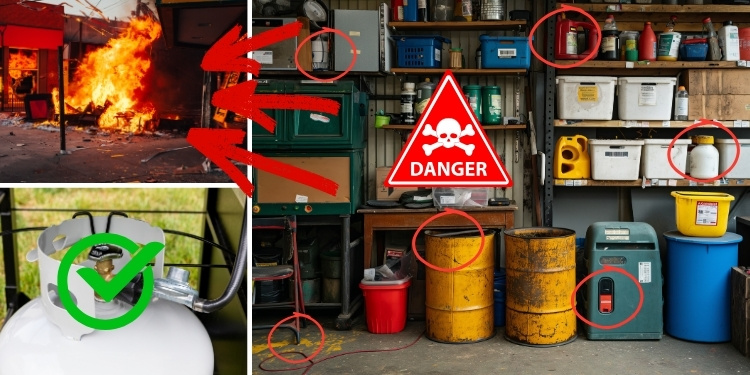Time-Based Layered Bag System for Practical Prepping

Podcast: Play in new window | Download
Preparedness isn’t about throwing a bunch of gear into one bag and hoping it works. And it’s not about having a bunch of bags and not knowing which to use. It’s about building systems—layered, intentional, and based on how people actually move through the world.
Most preppers focus on bag names—Bug Out Bag, INCH Bag, Go Bag—and that’s where confusion starts. The definitions shift. People get stuck wondering: Do I need different bags? What goes in each? Where do I start?
What if instead of chasing names, you focused on time?
This episode breaks down the Layered Bag System—bags built around how long they need to sustain you. Hour by hour. Day by day. From everyday carry to long-term relocation.
Every layer supports the next. Every bag has a job. Let’s break it down.
TL;DR: The Layered Bag System organizes preparedness by time, not names—helping you know which bag sustains you for hours, days, or weeks without confusion.
Quick Look at What You’ll Learn
The Time-Based Approach
The time-based approach eliminates the need to understand continually shifting definitions. Ask a group of 100 preppers what defines a bugout bag, or go bag, and you’re likely to get 125 definitions, with some changing their definition after the fact. You all know it’s true.
Heck, we as preppers love to turn definitions inside out in discussion groups and around the campfire. Unfortunately, though, planning preparedness based on definitions that change more than a drunk chameleon on a disco light.
So, rather than looking at bags and kits in the way we have always done it. We should, instead, look at the bags and kits we build in terms of time and function. I don’t care that there are moving definitions, so long as I know that my first bag buys me 24 hours of sustainability. I know that my next level up gets me 72 hours of options and survival, and so on. It eliminates the guesswork.
Likewise, have kits prepped and ready to address specific needs and depth of sustainment that are beyond what we expect with our primary sustainment bags. For example, where your 72-hour bag (bugout bag) is designed for three days of sustainment, a consumables resupply kit can keep you fed and hygienic for longer. A power/energy kit adds considerable depth to your power generation capability, exceeding what is appropriate for your sustainment bags.
Baseline: Everyday Carry (EDC)
Everyday Carry is the anchor point of the entire layered system. It’s what you already have on you—your pockets, purse, or belt—and it’s always with you. The purpose of EDC isn’t to provide days of survival. It’s to solve immediate problems, buy you time, and give you confidence as you move toward your next layer of support. Think of it as the foundation: simple, ever-present, and essential.
- Premise: Always with you, wherever you are.
- Use: Address immediate safety and bridge to your next level of sustainment.
- Duration: Immediate
- Examples: Everyday essentials—defensive items, small tools, light, phone, cash, basic medications, keys, etc.
Primary Bags
Core survival bags, each one building on the last.
1. 0-2 hours (Go Bag)
The Go Bag is the first true extension of your EDC. It’s the bag you grab whenever you step out of the house—whether you’re heading to the store, work, or running daily errands. The job of this bag isn’t to keep you going for days; it’s to cover short disruptions and needs. Think of it as the place for items you may want but don’t always carry in your pockets—over-the-counter meds, tissues, sunscreen, spare phone battery, or a little extra cash. It can also hold life-safety items like a tourniquet. For many women this may look like a purse, and for men it might be a sling bag, fanny pack, or small shoulder bag.
Use: Get from where you are (store, work, class) to your vehicle.
- Duration: 0–2 hours
- Bridge: EDC → Vehicle
2. 24-Hour Bag (Get Home Bag)
The Get Home Bag assumes your vehicle is no longer an option—maybe it’s broken down, the roads are blocked, or the situation has turned quickly. This bag is designed to carry you home on foot, sustaining you through 24 hours of independent movement. It should meet the core needs of the Survival Pyramid while remaining light and mobile enough to allow you to move quickly and think clearly. Its job isn’t to keep you in the field—it’s to help you finish the trip home when nothing else will.
- Duration: 24 hours
- Bridge: Vehicle → Home
3. 72-Hour Bag (Bug Out Bag)
Leave home quickly and sustain yourself for 3 days. The 72-hour bag assumes you must leave your home with little to no warning and won’t be able to return in the short term. It provides the core items necessary to meet the basic needs laid out in the Survival Pyramid. It’s also suitable for taking on road trips or longer-distance travel away from your main shelter, where your Get Home Bag may not be enough.
- Duration: 72+ hours
- Bridge: Home → Temporary safety
4. 7-Day Bag (INCH Bag)
“I’m Never Coming Home.” Full-scale relocation gear for indefinite survival. This bag assumes you’ve lost access to your primary shelter and are unlikely to return. It’s designed to support long-term off-grid living and should cover every layer of the Survival Pyramid for weeks or longer. It requires deep planning, skills, and physical readiness—it’s not a bug-out bag with extra stuff, it’s your new life in a pack.
- Duration: Weeks to months
- Bridge: Long-term relocation
Supplemental Kits and Bags
These don’t replace primary bags. They support, extend, or scale them. These kits can come in various forms—such as bags, boxes, or modules—designed for ease of transport and integration.
5. Cache Resupply Kit
- Use: Pre-staged stash hidden along a route or fallback location.
- Purpose: Gives you a second chance if gear is lost, stolen, or used up. Designed to meet basic survival needs for 3 days. Often overlooked but highly valuable for those with secondary shelters or extended bugout routes.
6. Consumable Resupply Kit
- Use: Add-on loadout to top off or extend consumable supplies.
- Purpose: Extends time in the field with extra fuel, meds, food, hygiene, batteries, etc. Typically stored at home and loaded into your vehicle before leaving.
7. Group Support Kit
- Use: Shared gear for family or a mutual assistance group (MAG).
- Purpose: Scales your ability to support others—medical, shelter, water, hygiene, comms, and high-use items.
8. Vehicle Kit
- Use: Your vehicle becomes both transportation and shelter.
- Premise: In a serious disaster, your vehicle may become your temporary home or mobile base. It should support multiple days of survival, act as mobile storage, and provide fallback shelter if your home is compromised.
Should include:
-
- Several days of supplies for all passengers
- Empty backpack(s) to load gear if you go on foot
- Repair and recovery gear
- Water, food, shelter, comms, medical, and heating supplies
9. Additional Kits to Consider
These modules can be added to any bag or vehicle kit depending on the conditions, mission, or season:
- Medical Kit
- Seasonal/Environmental Kit
- Communications Kit
- Power/Energy Kit
- Tools/Maintenance Kit
- Urban Kit
Flow of Use
Everything starts with EDC on your body. From there:
- Your EDC, when paired with your Go Bag, is designed to help you address immediate safety, security, and basic needs during your day.
- If your vehicle is operable, it gets you home or to a safer, more sustainable location.
- If your vehicle is not operable, transition to your Get Home Bag. Your Vehicle Kit can support or extend that movement.
- If your destination is beyond the range of your Get Home Bag, resupply from the vehicle before heading out.
- Once home, your 72-Hour Bag is ready to deploy.
- If home is no longer an option, the INCH Bag and Supplemental Kits sustain long-term relocation and independence.
The Bottom Line
Preparedness isn’t about having a pile of bags—it’s about knowing which one you need and when. The Layered Bag System eliminates the guesswork by focusing on time and function, rather than names and definitions. Whether you’re stepping out for the day, walking home, leaving town, or starting over, each layer has a purpose and a plan. Build it one layer at a time, tie it to reality, and you’ll be ready when the time comes to lean on it.
Additional Resources
Frequently Asked Questions
What’s the difference between a Go Bag and a Bug Out Bag?
A Go Bag covers short disruptions—usually a few hours—and helps you get back to your vehicle. A Bug Out Bag (72-Hour Bag) is for when you need to leave home fast and survive for days without support.
How do I know which bag to build first?
Start with your EDC and Go Bag. These are the most immediately useful layers and easiest to build. Once those are dialed in, work your way outward through the system.
Can one bag cover multiple time ranges?
Technically, yes—but it creates confusion and slows you down in an emergency. This system separates each layer by time and function to keep things fast, focused, and easy to manage.
What if my Get Home Bag isn’t enough to make it home?
That’s where your Vehicle Kit and supplemental gear come in. If your trip home is longer than 24 hours, your vehicle should have extra supplies—or you should consider staging a cache bag along your route.
Does this system change if I live in a city instead of a rural area?
The structure stays the same, but the details shift. In a city, you might focus more on movement through crowds, civil unrest, or limited parking. In rural areas, you’re more likely dealing with distance, terrain, and weather exposure.
📌 Next StepsTake a look at how you move through your average day.
- Where are the weak spots in your current layers?
- What would strand you between your office and your vehicle? Between your vehicle and home?
Pick just one layer—EDC, Go Bag, Get Home, or 72-Hour—and build or audit it this week. Make sure it supports you for the time it’s meant to cover. Then stack the next layer when you’re ready.
Read the full article here









